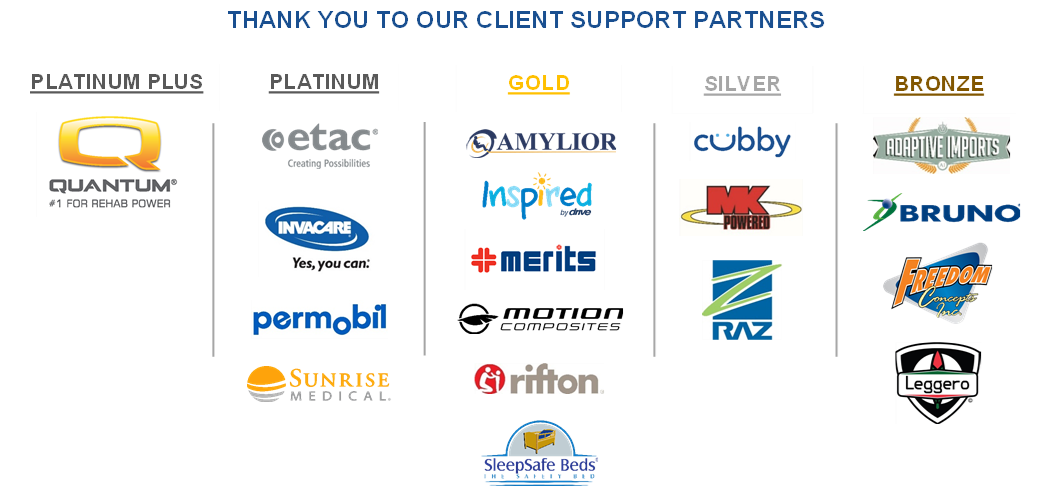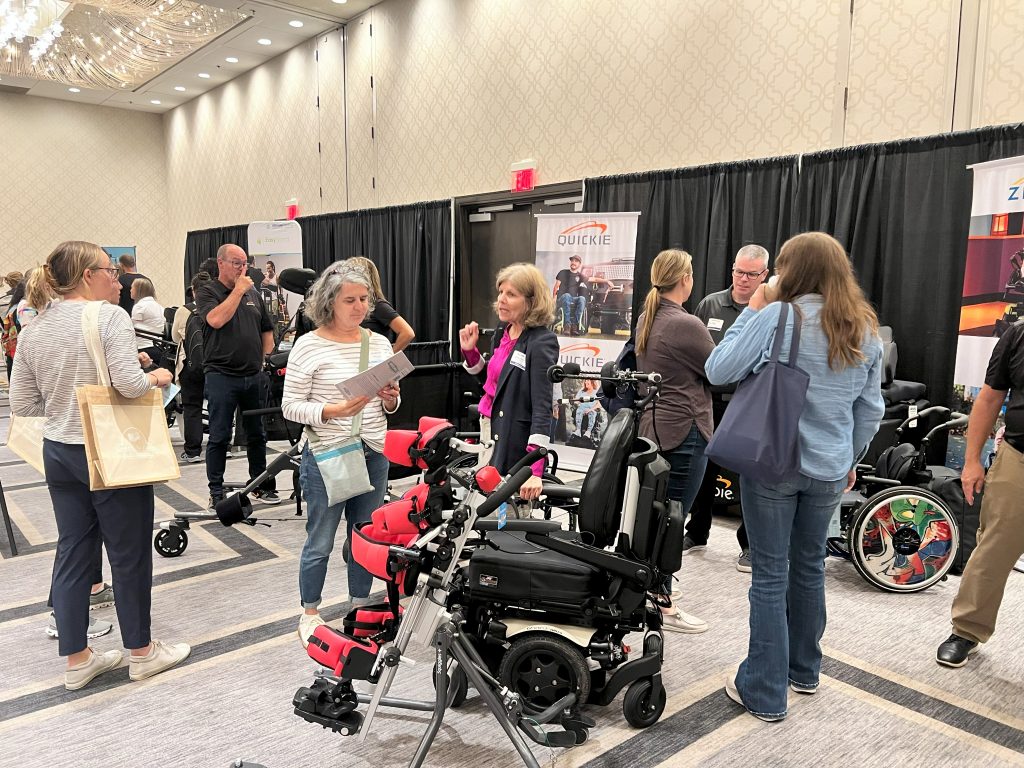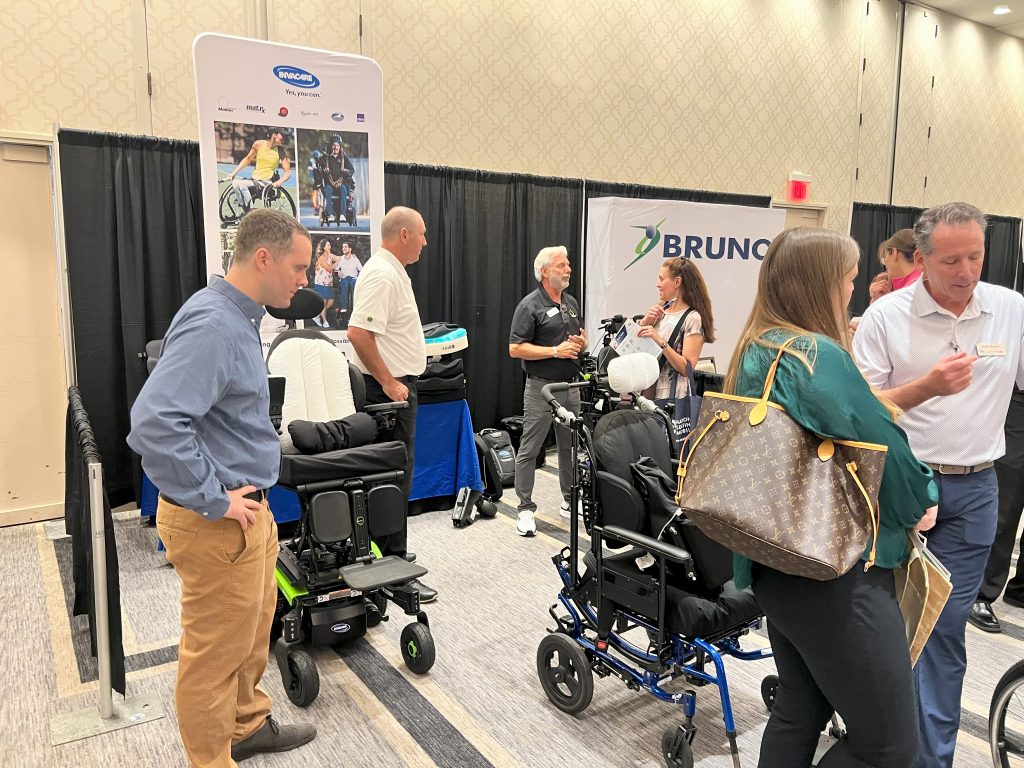CHICAGO MOMENTUM ACADEMY EDUCATION & TECHNOLOGY EXPO
Thursday, September 18, 2025
Doubletree Hotel
Oakbrook, IL
Event Highlights
- Earn up to 6 hours of continuing education (CE) credits for PT, PTA, OT, COTA, ATP
- Network with industry professionals
- Exhibit hall with the latest assistive technology
- Breakfast and lunch provided
The rate is: $69 for up to 6 CE credits
DOUBLETREE OAKBROOK

1909 Spring Road, Oakbrook, IL 60523
Deadline to reserve a room at $134 rate is Friday, September 5.
SCHEDULE OF EVENTS
7:00am - 7:45am: Registration
7:45am - 8:00am: Kick-off
8:00am - 12:00pm: Education Courses
12:00pm - 1:00pm: Lunch
1:00pm - 5:00pm: Education Courses
The Supplier Exhibit Hall will be open throughout
the day with 2 hours of dedicated exhibit hall time.
Click here for full event schedule.
CONTINUING EDUCATION COURSES
Prescriptive Planning - Turning Chaos Into (an) Order
0.1 CEUs / Intermediate
Presented by: TBD
Etac/Ki Mobility
Every wheelchair fitting starts with a good eval, from client history to equipment trials, to careful measurements (and let’s not forget to get the rider’s and caregivers’ thoughts on what matters to them). Once we have funding, we do our delivery and fitting and we’re done with that rider for the next 5 years, right? We know that’s not the case at all. Riders change. Whether it’s growth, weight changes, changes in the rider’s condition, or evolution of wheelchair skills, riders change. Can the chair you prescribed change with them?
In this session, we are going to look at a variety of the decisions that you often face when configuring a chair and help navigate some of options that will allow you to build future adjustments into the chair. We will discuss some of the more critical adjustments to consider, and what their impact can be on present and future performance. We will also discuss some of the set-up factors you need to consider when fitting and adjusting your chair and will offer some tips on how to avoid some of the mistakes that can rob a chair of its efficiency and performance.
Advancing Child Development: The Role of Gait Trainers in Mobility
0.1 CEU / Intermediate
Presented by: Jessica Pedersen, OTD, MBA, OTR/L, ATP/SMS
Sunrise Medical
This one-hour course will be a recap of the typical gait development and its critical role in a child's brain and musculoskeletal growth. This course will delve into the numerous benefits of promoting early active mobility in children with additional needs, focusing on hip joint and muscle development. Participants will explore the evidence on gait trainers, evaluate the pros and cons of various styles, and learn about the innovative features and accessories of gait trainers. These tools can significantly enhance child exploration, interaction, and participation. Real-world case studies will illustrate the practical application of clinical theories using gait trainers.
Pediatric Wheelchair Cushions and Backs - Matching Technology and Needs
0.1 CEUs / Intermediate
Presented by: TBD
Etac/Ki Mobility
For many years, there were only a couple basic choices of primary supports for pediatric wheelchair users: custom configured or custom molded. The available options for primary supports, backrests and cushions, for the pediatric client have expanded considerably over the years, and today there are a number of off-the-shelf, out-of-the-package products available. This greater range of available products requires professionals to be more discerning regarding the variety of choices before them, and recognize which product accomplishes the objective in a clinically appropriate way. We know that children are not just a smaller version of the adult client and that their needs can be different. What does the research say about what is important for the pediatric client regarding providing postural support, addressing postural asymmetries, maintaining tissue integrity, facilitating function, etc. This presentation will explore the types of primary supports on the market, and seek to inform clinical practice by discussing considerations and applications of the various types of technology for primary supports for the pediatric wheelchair user.
Pediatric Adaptive Standing: Five Considerations for Optimizing the Outcomes
0.1 CEU / Intermediate
Presented by: Elena Noble
Rifton
This 60-minute presentation will address five novel and up-to-date considerations for pediatric adaptive standing. Specifically: standing as physical activity, positioning for postural control, hip abduction positioning and contracture management, active participation in the sit-to-stand transfer, and creating opportunities for social engagement and participation in standing. Current evidence supporting these interventions will be presented along with case examples to illustrate applications of these concepts. A segment for Q&A will conclude the session.
Beyond the Base: The Seating Professionals Responsibility of Educating on Manual Wheelchair Components
0.1 CEU / Intermediate
Presented by: Petra Conaway, PT, DPT, ATP
Motion Composites
When configuring an ultralight manual wheelchair, significant time and consideration is spent on the base. Accessories are necessities of the seating system to complete the configuration. As professionals, we must educate clients and caregivers on the advantages and disadvantages of each selected component, creating an understanding of how components contribute to overall function and satisfaction.
Providing Safe Environments with Adaptive Positioning Equipment
0.1 CEU / Beginner to Intermediate
Presented by: Melissa Tally, PT/ATP
Adaptive Imports
There are several misconceptions and unknown facts around adaptive positioning equipment for patients with neurodiverse diagnoses. This course will present current evidence-based practice and standards of care supporting positioning equipment to provide improved access, function, and safety in all environments. There are four main areas in which adaptive equipment is most often needed: including home or school, transport, mobility, and communication. We will discuss the medically necessary clinical presentation justifying these supports and the process of planning, assessing, and obtaining the appropriate equipment for each client. The acquisition of this adaptive equipment, when needed, can greatly impact the safety, function, and quality of life of the client and their family.
Getting Connected
0.1 CEU / Intermediate to Advanced
Presented by: Lisa Rotelli
Invacare/ASL
Individuals with mobility challenges can also struggle with access to mobility and to everyday technology. When someone also needs to augment communication those challenges compound. We will discuss strategies and view case studies for building access for persons with the most complex needs and to integrating their access systems to promote more independence.
The Drive for Function and Development: Alternative Drive Control Considerations for Early Power Mobility
0.1 CEU / Beginner
Presented by: Jay Doherty, OTR, ATP/SMS
Quantum Rehab
Assessing an end user for power mobility can be an intimidating task. Decisions that are made will have an impact on the individual’s quality life, functional mobility, physical well-being, and social interactions. This task can seem even more daunting when it comes to the pediatric end user. Children have the natural desire to move, explore, and learn. Research has shown that there is a strong correlation between self-initiated mobility and the development of visual, cognitive, social, language, and perceptual skills. This course will discuss the characteristics and decision-making process for alternative drive control devices, as well as the special considerations on early power mobility intervention. Potential assessment and training tools for pediatric power mobility will also be explored.
3:00-5:00pm
Move to Learn
0.2 CEU / Intermediate to Advanced
Presented by: Lisa Rotelli
Invacare/ASL
This course will discuss helping children learn and develop functional skills through the use of powered mobility. We will discuss designing activities to help teach motor skills that support classroom curriculums. Understanding how consistent messaging can help develop language and describe how powered mobility plays a role in this process. Showing what connectivity options are necessary to provide successful outcomes for the most complex patients.
3:00-4:00pm
Evidence-Driven MWC Configuration: Optimizing Fit and Function for Different Body Types and Propulsion Methods
0.1 CEU / Intermediate
Presented by: Catherine Sweeney, PT, ATP/SMS
Permobil
This 1-hour course is designed to help providers and clinicians develop best practices for recommending complex rehab technology (CRT) manual wheelchairs for individuals with varying body proportions and propulsion styles. Using the ICF model, the course will guide participants through the decision-making process, balancing evidence with functional outcomes to ensure successful CRT seating and wheeled mobility solutions. Through case examples and clinical reasoning discussions, participants will learn to identify clients' individual clinical and functional goals, driving configuration and component recommendations that enhance functional mobility outcomes, participation, and overall satisfaction with the equipment, ensuring a good person-technology match.
4:00-5:00pm
Tailored Seating Solutions for High-Risk Clients
0.1 CEU / Beginner
Presented by: Catherine Sweeney, PT, ATP/SMS
Permobil
In the wheelchair seating arena, providing a seating system for the clients at high risk for pressure injury can be both intimidating and overwhelming. This 1-hr course provides an in-depth understanding of how to incorporate evaluation findings, seating characteristics, and client goals when formulating equipment recommendations for high-risk clients. Participants will learn to identify clinical indicators of pressure injury risk, apply ISO wheelchair cushion performance standards, and recognize key material traits in seating products. A complex case example will be discussed to illustrate the process of integrating evidence and client goals to enhance functional independence.
By the end of this course, participants will be equipped with the knowledge to make informed, evidence-based, and client-centered seating recommendations, ultimately improving the quality of life for wheelchair users.
Explore the course offerings. You can pick & choose the classes you'd like to attend during registration.





